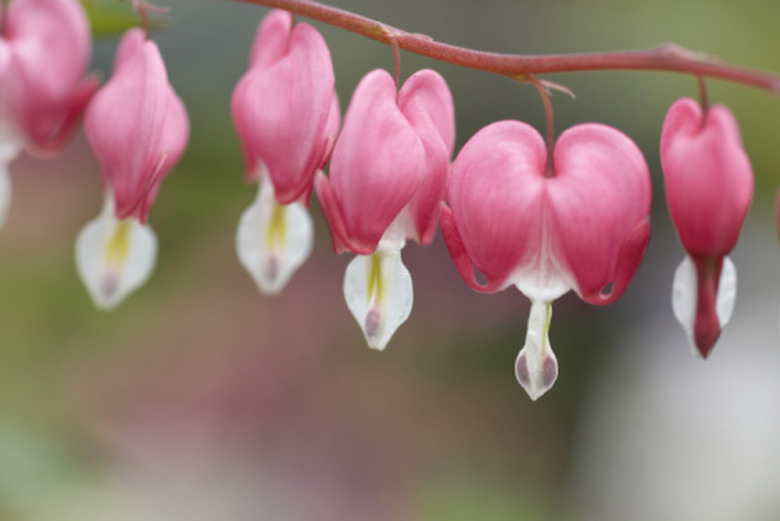How To Grow Bleeding Hearts In Florida
Things Needed
- Rake
- Herbicide
- Peat
- Manure
- Compost
- Shovel
- Trellis
- Pruning shears
- Container
- Hanging basket
- Potting soil
Bleeding heart (Clerodendrum thomsoniae) prefers warm, humid conditions, making Florida's weather conditions optimal. It is hardy in United States Department of Agriculture hardiness zones 9 through 12, acting like a perennial in Central and South Florida. North Florida plants will die to the ground during frosts and freezes, but they will resprout in spring. The evergreen shrub has a vine-like habit, growing up to 15 feet tall. Bleeding heart has red and white bell-like flowers, blooming from spring through summer.
Growing Outside
Step 1
Remove weeds from a planting site located in partial shade with well-drained soil. Pull or rake the vegetation from the planting bed. If using an herbicide to kill the vegetation, do not use a product that has long-term effects to the soil, as it may kill the bleeding heart.
Step 2
Amend the planting site with peat, manure or compost, as the majority of Florida soil is sandy, lacking organic nutrients. Work the organic material into the planting area's soil to a depth of approximately 6 to 8 inches.
Step 3
Dig a hole twice as wide as the bleeding heart's root ball and as deep as it is presently growing. Place the root ball into the hole and backfill with soil. Firm the soil around the plant by patting it down with your hands.
Step 4
Install a trellis approximately 6 inches behind the bleeding heart, giving it something to grow on, if growing the plant as a vine. Push the trellis legs into the soil approximately 8 to 12 inches. Bleeding heart has a twining growth habit, instead of forming tendrils that hold onto the trellis or arbor.
Step 5
Water the bleeding heart immediately after planting, saturating the roots, and water regularly. Plants perform best in moist, well-drained soils. If your area of Florida is suffering drought conditions, water approximately three times weekly to keep the soil moist.
Step 6
Prune bleeding hearts to control their size, shape and make them bushier. If growing plants as a shrub, regular pruning will make them branch out instead of being more vine-like.
Step 7
Protect bleeding heart plants if your winter temperatures become cold, as the plants are cold tolerant to 45 degrees Fahrenheit. Cover plants with cloth coverings and water well before the frosty weather arrives.
Growing Inside Containers
Step 1
Fill a hanging basket or other container half full with a well-draining, rich, potting medium. Using containers that do not drain will cause the soil to be overly saturated and the bleeding heart will develop root rot and die.
Step 2
Remove the bleeding heart from its container and place inside the new container. Fill with soil and pack down around the plant using your hands, firming it up.
Step 3
Water the container after planting the bleeding heart, allowing water to run from the bottom. Water the plant every other day if necessary, as containerized soil dries out quickly. Stick your finger into the container's soil and if the top 1 to 2 inches are dry, apply water.
Step 4
Situate the container or hanging basket in an area that receives partial sun throughout the day.
Step 5
Bring the hanging basket or container indoors to a warm location if winter temperatures turn cold. Return the bleeding heart to its outdoor location once warm, spring weather returns.
